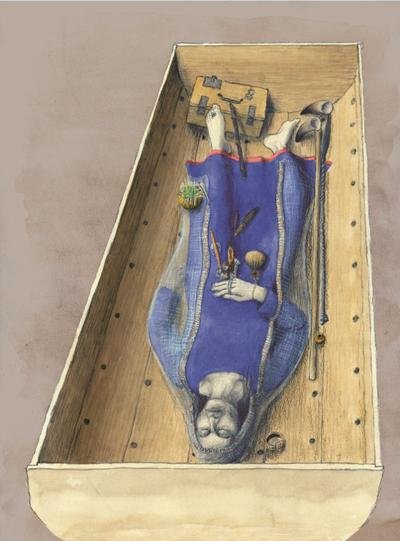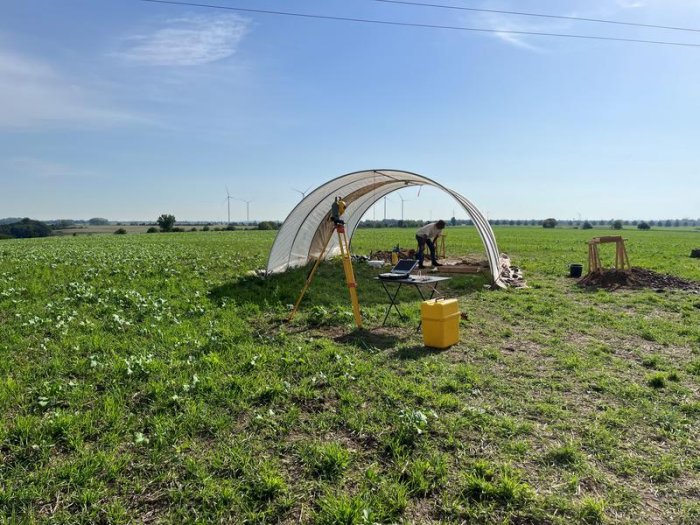Mysterious 9,000-Year-Old Shaman Burial In Bad Dürrenberg – One Of Central Europe’s Most Spectacular Archaeological Discoveries
Ellen Lloyd - AncientPages.com - About 9,000 years ago, an influential and respected woman was put to rest in a burial in Bad Dürrenberg, Germany. She was buried in a sitting position with a child of about six months in her arms. The child was not hers, and there is no evidence the baby had been sacrificed. Her spectacular clothes and lavish burial offer evidence she was a woman of high social status. We do not know her name, but we know she was 30-40 when she died.
A reconstruction of the female shaman's headdress. Image courtesy: State Office for Heritage Management and Archaeology Saxony-Anhalt, Karol Schauer.
Her grave was located in Bad Dürrenberg, a town in Saxony-Anhalt. It is today referred to as one of the most spectacular discoveries in Central European archaeology.
When examining the ancient grave goods, scientists could determine the woman buried in Bad Dürrenberg was a shaman.
Shamanism is an ancient and powerful spiritual practice that dates from humanity's earliest beginnings. Some say shamanism is the "ancestor" of all our modern religions.
"The word "shaman" comes from the language of the Evenki peoples, a Tungusic tribe in Siberia. This is a word whose meaning has to do with esoteric knowledge and extraordinary spiritual abilities and as such a shaman is often defined as an intermediary between the human and the spirit worlds. In shamanic cultures, the word "shaman" has come to mean "the one who sees in the dark" or "the one who knows." 1
Ancient people believed shamans could open the doors to spiritual and invisible worlds. Credit: Adobe Stock - Nejron Photo
We have gained a better knowledge of how Shamanism was practiced globally based on studies of archaeological findings, ancient texts, and oral traditions.
In Northern Europe, ancient shamans could be either male or female, but it was most common that women gained the role.
In Norse mythology, several stories deal with the Völva, a mighty female shaman and seer.
She held an essential place in the ancient Viking society, and her powers were considered so strong that not only Vikings feared her prophecies.
The Völva was considered a Seiðr (sometimes anglicized as seidhr, seidh, seidr, seithr, seith, or seid) is an Old Norse term for a type of sorcery that was practiced in Norse society during the Late Scandinavian Iron Age.
As often happens with mythical stories, few hold the events as genuine until scientific evidence confirms that events, places, or objects are authentic.
The Völva was long treated as a fictional character, but archaeological discoveries have confirmed this powerful ancient woman did exist in the past.
While excavating near the Fyrkat Viking fortress, archaeologists found about 30 Viking Age graves, but one was more unusual. Examinations of the burial revealed it belonged to a Norse shaman, a Völva.
The buried seeress from Fyrkat – reconstruction drawing by Thomas Hjejle Bredsdorff. Image credit: National Museum of Denmark
There are similarities between the ancient shaman burial in Fyrkat, Denmark, and Bad Dürrenberg, which is worthy of further study.
The ancient shaman woman in the Bad Dürrenberg grave was wearing a headdress made of deer antlers and animal tooth pendants, showing her unique position as her group's spiritual leader.
"The enormous diversity of animal species represented in the grave, of which not all would have been just food supplies for the afterlife, is remarkable. Ethnographic comparisons suggest that some objects are to be interpreted as requisites of shamanistic practices.
The analysis of the woman's skeleton revealed that her two uppermost cervical vertebrae were malformed and that blood vessels in the lower skull area could have been spatially restricted. This malformation may have made her a special person. Anthropologists suspect that by holding her head in a certain position, she was able to clamp off a blood vessel. It is possible this led to an involuntary eye movement, a so-called nystagmus. 2
During a recent archaeological excavation in Bad Dürrenberg scientists unearthed a 9,000-year-old hunting camp. This place is particularly interesting as it is located only six kilometers from the famous Bad Dürrenberg shaman burial, leading us to assume there could be an ancient connection between these two sites.
The video has English subtitles.
"Since the beginning of August, archaeologists of the State Office for Heritage Management and Archaeology Saxony-Anhalt have been investigating the approximately 9,000-year-old site. Eight excavation squares, each one by one meter in size, were excavated down to the geological subsoil.
In addition to numerous artifacts in the plow horizon, an undisturbed find layer and pits could be determined. Numerous stone implements, fragments of bones, and antlers were recovered. The large number of microliths, which may have served as tips for hunting arrows, is striking.
However, hardly any scrapers or tools in Dehlitz indicate the further processing of hunted prey. The site could have been a hunting camp that was used periodically.
The excavation site where scientists found a 9,000-year-old hunting camp is near the shaman's burial. Credit: Oliver Dietrich - State Office for Heritage Management and Archaeology Saxony-Anhalt
Due to the spatial proximity to the grave of Bad Dürrenberg, the similarity of the raw material used for the manufacture of the stone tools, and the comparable tool shapes, a connection between the hunting camp near Dehlitz and the "Bad Dürrenberg shaman" is obvious," the research team informs. 3
The mystery of the Bad Dürrenberg extraordinary burial seems to be slowly being solved, and the presented finds offer a fascinating glimpse into Europe's ancient past.
"The Bad Dürrenberg burial does not explain the ‘origins of shamanism’, nor does it provide a general key to an understanding of this phenomenon. It presents unique lines of evidence which suggest that in a prehistoric context, mental or physical peculiarity could be interpreted in terms of shamanistic abilities and were highly valued by the respective society." 4
Researchers have gained valuable information about the female shaman buried in Bad Dürrenberg, and we cannot exclude the possibility that new exciting finds can be expected soon.
Scientists have produced a fascinating series Archaeology exclusive, presenting the results of the latest research on the shaman since 2021. These films have English subtitles.
Written by Ellen Lloyd – AncientPages.com
Copyright © AncientPages.com All rights reserved. This material may not be published, broadcast, rewritten or redistributed in whole or part without the express written permission of AncientPages.com
Expand for references- Sandra Ingerman MA, Hank Wesselman Ph.D. - Awakening to the Spirit World: The Shamanic Path of Direct Revelation
- The shaman from Bad Dürrenberg - Landesamt für Denkmalpflege und Archäologie Sachsen-Anhalt - Landesmuseum für Vorgeschichte
- The shaman from Bad Dürrenberg - Landesamt für Denkmalpflege und Archäologie Sachsen-Anhalt - Landesmuseum für Vorgeschichte
- Porr, Martin & Alt, Kurt. (2006). The Burial of Bad Dürrenberg, Central Germany: Osteopathology and Osteoarchaeology of a Late Mesolithic Shaman's Grave. International Journal of Osteoarchaeology. 16. 395 - 406. 10.1002/oa.839.
More From Ancient Pages
-
 Birch Bark Tar Production Techniques Offer Evidence Neanderthals Had Cognitive Skills Similar To Modern Thinking
Archaeology | Sep 26, 2023
Birch Bark Tar Production Techniques Offer Evidence Neanderthals Had Cognitive Skills Similar To Modern Thinking
Archaeology | Sep 26, 2023 -
 Timur: Brutal Military Leader And His Desire To Conquer But Not To Rule
Featured Stories | Mar 13, 2019
Timur: Brutal Military Leader And His Desire To Conquer But Not To Rule
Featured Stories | Mar 13, 2019 -
 On This Day In History: Terrorist Attacks On World Trade Center And Pentagon – On Sep 11, 2001
News | Sep 11, 2016
On This Day In History: Terrorist Attacks On World Trade Center And Pentagon – On Sep 11, 2001
News | Sep 11, 2016 -
 4,000-Year-Old Tomb Altóir Na Gréine Rediscovered By Folklorist In County Kerry, Ireland
Archaeology | Jan 24, 2024
4,000-Year-Old Tomb Altóir Na Gréine Rediscovered By Folklorist In County Kerry, Ireland
Archaeology | Jan 24, 2024 -
 Celtiberians: Intriguing Martial Culture And Their Skilled Warrior Infantry
Civilizations | Jul 13, 2024
Celtiberians: Intriguing Martial Culture And Their Skilled Warrior Infantry
Civilizations | Jul 13, 2024 -
 Survivors Of The Latest Ice Age Thrived Near The Sea Of Galilee 23,000 Years Ago
Archaeology | Jan 27, 2022
Survivors Of The Latest Ice Age Thrived Near The Sea Of Galilee 23,000 Years Ago
Archaeology | Jan 27, 2022 -
 Has The Mystery Of The 11,000-Year-Old Amazonian Rock Art Been Solved?
Places | Nov 15, 2024
Has The Mystery Of The 11,000-Year-Old Amazonian Rock Art Been Solved?
Places | Nov 15, 2024 -
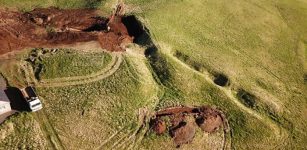 Surprising Discoveries In Mysterious Giant Viking-Era Cave In Iceland Can Confirm Norse Sagas
Archaeology | May 31, 2022
Surprising Discoveries In Mysterious Giant Viking-Era Cave In Iceland Can Confirm Norse Sagas
Archaeology | May 31, 2022 -
 World’s Oldest Mosaics Of Biblical Jonah And The Whale Discovered
Archaeology | Jul 23, 2017
World’s Oldest Mosaics Of Biblical Jonah And The Whale Discovered
Archaeology | Jul 23, 2017 -
 Mystery Of The Ancient Red Sign Witnessed In The Sky Over Japan
News | Mar 31, 2020
Mystery Of The Ancient Red Sign Witnessed In The Sky Over Japan
News | Mar 31, 2020 -
 What Was Lex Salica?
Ancient History Facts | Dec 13, 2017
What Was Lex Salica?
Ancient History Facts | Dec 13, 2017 -
 Mysterious Megaliths Of Russia May Offer Evidence Of An Ancient Advanced Lost Civilization
Ancient Technology | Jul 22, 2017
Mysterious Megaliths Of Russia May Offer Evidence Of An Ancient Advanced Lost Civilization
Ancient Technology | Jul 22, 2017 -
 Ancient Beliefs About The Soul
Civilizations | Mar 8, 2016
Ancient Beliefs About The Soul
Civilizations | Mar 8, 2016 -
 Paracelsus: Physician, Alchemist, Philosopher Well Ahead Of His Time
Featured Stories | Apr 28, 2016
Paracelsus: Physician, Alchemist, Philosopher Well Ahead Of His Time
Featured Stories | Apr 28, 2016 -
 God Odin Was Exiled From Asgard – The Kingdom Of The Gods – But He Had No Regrets For Breaking Norse Society’s Norms
Featured Stories | Feb 10, 2018
God Odin Was Exiled From Asgard – The Kingdom Of The Gods – But He Had No Regrets For Breaking Norse Society’s Norms
Featured Stories | Feb 10, 2018 -
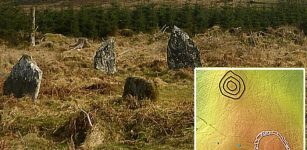 Baltinglass Hills: Prehistoric Irish Monuments May Have Served As Pathways For The Deceased – New Evidence
News | Apr 30, 2024
Baltinglass Hills: Prehistoric Irish Monuments May Have Served As Pathways For The Deceased – New Evidence
News | Apr 30, 2024 -
 Scientists Unravel The Mystery Of The Alexander Sawney Bean Legend & Cave-Dwelling Cannibals In Scotland
Myths & Legends | Sep 24, 2015
Scientists Unravel The Mystery Of The Alexander Sawney Bean Legend & Cave-Dwelling Cannibals In Scotland
Myths & Legends | Sep 24, 2015 -
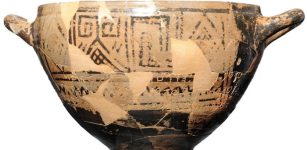 Mystery Of The Tomb Of Nestor’s Cup Unraveled
Archaeology | Oct 6, 2021
Mystery Of The Tomb Of Nestor’s Cup Unraveled
Archaeology | Oct 6, 2021 -
 Humans Spread The Black Death – Not Rats – Scientists Say
Archaeology | Feb 7, 2018
Humans Spread The Black Death – Not Rats – Scientists Say
Archaeology | Feb 7, 2018 -
 Neanderthals’ Lack Of Drawing Ability Could Explain Why Modern Humans Became Smarter
Archaeology | Feb 11, 2018
Neanderthals’ Lack Of Drawing Ability Could Explain Why Modern Humans Became Smarter
Archaeology | Feb 11, 2018



